|
|
 |
Fiche d'espèce de Copépode |
|
|
Calanoida ( Ordre ) |
|
|
|
Metridinidae ( Famille ) |
|
|
|
Pleuromamma ( Genre ) |
|
|
| |
Pleuromamma borealis (F. Dahl, 1893) (F,M) | |
| | | | | | | Syn.: | Pleuromma borealis F. Dahl,1893;
Pleuromamma gracilis : Esterly, 1905 (p.175, fig.F, Rem.F,M); 1912; Farran, 1926 (part.);
Pleuromamma gracilis esterlyi T. Scott, 1912 (1913) (p.535, figs.F) | | | | Ref.: | | | Giesbrecht & Schmeil, 1898 (p.110); Farran, 1929 (p.209, 262, figs.F, Rem.); Steuer, 1932 a (p.39, 52, 67, 78, figs.F,M); Rose, 1933 a (p.182, figs.F); Massuti Alzamora, 1942 (p.91, figs.F); Farran, 1948 f (n°17, p.3, figs.F,M); Brodsky, 1950 (1967) (p.309, figs.F,M); Grice, 1962 (p.218, figs.F); Giron-Reguer, 1963 (p.33, figs.F); Paiva, 1963 (p.56); Chen & Zhang, 1965 (p.70, figs.F,M); Vervoort, 1965 (p.111, Rem.); Vilela, 1968 (p.24, figs.F,M); Corral Estrada, 1970 (p.176); Arcos, 1975 (p.18, figs.F,M); Dawson & Knatz, 1980 (p.5, figs.F,M); Björnberg & al., 1981 (p.642, figs.F); Gardner & Szabo, 1982 (p.336, figs.F,M); Zheng & al., 1982 (p.52, figs.F); Ferrari, 1984 a (p.167, figs.F); Kim & al., 1993 (p.270); J.S. Park & Mauchline, 1994 (p.108 & suiv., fig.F); Bradford-Grieve & al., 1999 (p.884, 949, figs.F,M); Bradford-Grieve,1999 b (p.120, figs.F,M, Rem., figs.179, 192); G. Harding, 2004 (p.31, figs.F,M); Vives & Shmeleva, 2007 (p.377, figs.F,M, Rem.); Cheng F. & al., 2013 (p.119, molecular biology, GenBank) | 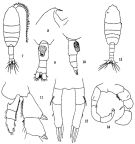 issued from: Q.-c Chen & S.-z. Zhang in Studia Marina Sinica, 1965, 7. [Pl.23, 7-14]. Female (from E China Sea): 7, habitus (dorsal); 8, forehead (lateral); 9, urosome (ventral); 10, idem (lateral right side); 11, endopod of right P2 (posterior); 12, P5 (posterior). Male: 13, habitus (dorsal); 14, P5 (posterior).
|
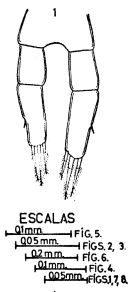 issued from : J. Corral Estrada in Tesis Doct., Univ. Madrid, A-129, Sec. Biologicas, 1970. [Lam.48, fig.1]. Female (from Canarias Is.): 1, P5.
|
 issued from : F. Giron-Reguer in Thèse Fac. Sc. Paris, 1963 [Fig.13]. Female (from Alboran Sea): P5.
|
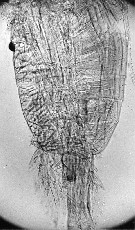 issued from : F. Giron-Reguer in Thèse Fac. Sc. Paris, 1963 [Fig.12]. Female: thoracic segments and urosome (ventral view).
|
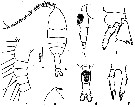 issued from : Z. Zheng, S. Li, S.J. Li & B. Chen in Marine planktonic copepods in Chinese waters. Shanghai Sc. Techn. Press, 1982 [p.52, Fig.29]. Female: a, habitus (dorsal); b, forehead (lateral); c-d, urosome (lateral and ventral, respectively); e, proximal segments of A1; f, basipodite segment 2, exopodal segment 1 and endopod of P2; g, P5. Scale bar in mm.
|
 issued from : C.O. Esterly in Univ. Calif. Publs. Zool., 1905, 2 (4). [p.175, Fig.33, c]. As Pleuromamma gracilis. Female (from San Diego Region): c, P5.
|
 issued from : D.F.R. Arcos in Gayana, Zool., 1975, 32. [Lam.V, Figs.48-51]. Female (from Bahia de Concepcion, Chile): 48-49, habitus (dorsal and lateral, respectively) [ Juveniles ? ]; 50, P5; 51, P2.
|
 issued from : G.D. Grice in Fish. Bull. Fish and Wildl. Ser., 1962, 61. [p.217, Pl.22, Figs.16-18]. Female (from equatorial Pacific): 16-17, habitus (dorsal and lateral, respectively); 18, P5.
|
 issued from : G. Harding in Key to the adullt pelagic calanoid copepods found over the continental shelf of the Canadian Atlantic coast. Bedford Inst. Oceanogr., Dartmouth, Nova Scotia, 2004. [p.31]. Female & Male. Male: Right P5 with s short knobbed process (arrowed) on the exopodal segment 2.
|
 issued from : J.M. Bradford-Grieve in The Marine Fauna of New Zealand: Pelagic Calanoid Copepoda. National Institute of Water and Atmospheric Research (NIWA). NIWA Biodiversity Memoir, 111, 1999. [p.120, Fig.81]. Female (from 41°41S, 167°03'E): B, habitus (dorsal); C, basipod 2 and endopod segment 1 of left P2; D, P5. Nota: L = left leg; R = right leg. Female characteristics: Pigment spot on the right side - Very similar to P. gracilis- Genital boss flattened in lateral view. - P5 3-segmented with 2 free segments, terminated by 3 long spines, the outer the longest. Male characteristics: Pigment spot on right side.
- Differs from P. gracilis by exopod segment 1 of left P5 bearing a shorter appendage without a knob; distal segment of right leg shorter and wider.
Nota: The identity of the Southwest Pacific males is not always clear, therefore there is a possibility that P. gracilis, P. piseki, P. borealis have been confused when they have not been dissected.
| | | | | Ref. compl.: | | | Massuti Alzamora, 1942 (p.91); Lysholm & al., 1945 (p.32); Sewell, 1948 (p.503, 508, 514, 547, 549); C.B. Wilson, 1950 (p.289); Grice & Hart, 1962 (p.287, table 4: abundance); Duran, 1963 (p.20, Rem.); Giron-Reguer, 1963 (p.33); Grice, 1963 a (p.496); Ahlstrom & Thrailkill, 1963 (p.57, Table 5, abundance); Björnberg, 1963 (p.51, Rem.); Unterüberbacher, 1964 (p.27); De Decker & Mombeck, 1964 (p.13); Grice & Hulsemann, 1965 (p.224); Mazza, 1966 (p.71); 1967 (p.329); Fleminger, 1967 a (tabl.1); De Decker, 1968 (p.45); Shih & al., 1971 (p.42); Timonin, 1971 (p.281, trophic group); Roe, 1972 (p.277, tabl.1, tabl.2); 1972 b (p.549, Rem.); Björnberg, 1973 (p.338, 388); Corral Estrada & Pereiro Muñoz, 1974 (tab.I); Vives & al., 1975 (p.46, tab.II, III, IV, XII); Peterson & Miller, 1976 (p.14, Table 1, 3, abundance vs interannual variations); Deevey & Brooks, 1977 (p.256, tab.2, Station "S"); Timonin & Voronina, 1977 (p.292); Tranter, 1977 (p.596, 602); Peterson & Miller, 1977 (p.717, Table 1, seasonal occurrence); Carter, 1977 (1978) (p.36); Vives, 1982 (p.293); Kovalev & Shmeleva, 1982 (p.84); Dessier, 1983 (p.89, Tableau 1, 2, Rem., %); Tremblay & Anderson, 1984 (p.5); De Decker, 1984 (p.316, 359: chart); Sameoto, 1984 (p.767, vertical migration); Roe, 1984 (p.358); Guangshan & Honglin, 1984 (p.118, tab.); Longhurst, 1985 (tab.2); Greze & al., 1985 (p.9); Brenning, 1985 a (p.28, Table 2); Wishner & Allison, 1986 (tab.2); Brenning, 1986 (p.11, spatial distribution, T-S diagram, Rem.); Saraswathy, 1986 (p.189); Madhupratap & Haridas, 1986 (p.105, tab.1); Lozano Soldevilla & al., 1988 (p.59); Dessier, 1988 (tabl.1); Timonin, 1990 (p.479); Yoo, 1991 (tab.1); Ashjian & Wishner, 1993 (p.483, abundance, species group distributions); Seguin & al., 1993 (p.23, Table 2: abundance, %), p.26, Rem.); Morales C.E. & al., 1993 (p.185); Landry & al., 1994 (p.55, abundance, grazing); Landry & al., 1994 a (p.73, grazing, gut evacuation); Hays & al., 1994 (tab.1); Genin & al., 1994 (p.941, fig.5, patchiness); Shih & Young, 1995 (p.70); Errhif & al., 1997 (p.422); Timonin, 1997 (p.83, Rem.); Gilabert & Moreno, 1998 (tab.1, 2); Suarez-Morales & Gasca, 1998 a (p.110); Reid & Hunt, 1998 (p.310, figs.2, 3, Rem.); Lapernat, 2000 (tabl. 3, 4); Razouls & al., 2000 (p.343, Appendix); Haury & al., 2000 (p.69, Table 1); d'Elbée, 2001 (tabl. 1); Rebstock, 2001 (tab.2, 4); 2002 (p.71, Table 3, 5, 6, Fig.2, climatic variability); Holmes, 2001 (p.20); Sameoto & al., 2002 (p.13); Beaugrand & al., 2002 (p.1692); Beaugrand & al., 2002 (p.179, figs.5, 6); Labat & al., 2002 (p.741, tab.3); CPR, 2004 (p.59, fig.176); Lo & al., 2004 (p.89, tab.1); Hunt, 2004 (p.1, 74, Table 4.7); Zuo & al., 2006 (p.163: tab.1); Lavaniegos & Jiménez-Pérez, 2006 (p.152, tab.2, 3, Rem.); Mackas & al., 2006 (L22S07, Table 2); Khelifi-Touhami & al., 2007 (p.327, Table 1); Gaard & al., 2008 (p.59, Table 1, N Mid-Atlantic Ridge); Ayon & al., 2008 (p.238, Table 4: Peruvian samples); C.-Y. Lee & al., 2009 (p.151, Tab.2); Galbraith, 2009 (pers. comm.); Lidvanov & al., 2010 (p.356, Table 3); Takahashi & al., 2010 (p.317, Table 3); Schnack-Schiel & al., 2010 (p.2064, Table 2: E Atlantic subtropical/tropical); Mazzocchi & Di Capua, 2010 (p.426); Pepin & al., 2011 (p.273, Table 2, seasonal abundance); Tutasi & al., 2011 (p.791, Table 1, 3, fig.7, abundance distribution vs La Niña event, Rem. p.796, fig.11); in CalCOFI regional list (MDO, Nov. 2013; M. Ohman, comm. pers.); Lidvanov & al., 2013 (p.290, Table 2, % composition); Zaafa & al., 2014 (p.67, Table I, occurrence); Zakaria & al., 2016 (p.1, Table 1, Rem.); Benedetti & al., 2016 (p.159, Table I, fig.1, functional characters); El Arraj & al., 2017 (p.272, table 2, spatial distribution); Benedetti & al., 2018 (p.1, Fig.2: ecological functional group); Belmonte, 2018 (p.273, Table I: Italian zones) | | | | NZ: | 19 | | |
|
Carte de distribution de Pleuromamma borealis par zones géographiques
|
| | | | | | | | | | | | | | | | | |  issued from : M. Saraswathy in Mahasagar-Bull. Nat. Inst. Oceanogr., 1986, 19 (3). [p.190, Fig.2A]. issued from : M. Saraswathy in Mahasagar-Bull. Nat. Inst. Oceanogr., 1986, 19 (3). [p.190, Fig.2A].
Distribution of P. borealis in the Indian Ocean (upper water column of 200 m).
Triangle: South West Moonsoon season: April 16 to October 15 (white triangle = negative stations; black = animals collected). Circle: North East Moonsoon season: October 16 to April 15 (white circle = negative stations; black = numbers of ianimals collected).
Nota: This species appears to be more or less restricted to the area off the coast of Africa, with very few scattered occurrences towards the southern regions also south of Java. |
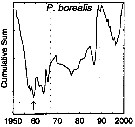 issued from : G.A. Rebstock in Global change Biology, 2002, 8. [p.77, Fig.2 t]. issued from : G.A. Rebstock in Global change Biology, 2002, 8. [p.77, Fig.2 t].
Climatic regime shifts and decadal-scale variability in calanoid copepod populations off southern California (31°-35°N, 117°-122°W.
Cumulative sums of nonseasonal anomalies from the long-term means of copepod abundance from years 1950 to 2000.
A negative slope indicates a period of below-average anomalies; a positive slope indicates a period of above-average anomalies. Abrupt changes in slope indicate step changes. Step changes are marked with arrow (downward -pointing for decreases).
The October 1966 cruise (prior to the increase in sampling depth), March 1976 cruise (prior to the 1976-77 climatic regime shift), and October 1988 cruise (prior to the hypothesized 1989 climatic regime shift) are marked with vertical lines. |
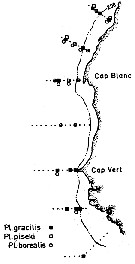 issued from : U. Brenning in Wiss. Z. Wilhelm-Pieck-Univ. Rostock - 35. Jahrgang 1986. Mat.-nat. wiss. Reihe, 5. [p.8, Fig.5]. issued from : U. Brenning in Wiss. Z. Wilhelm-Pieck-Univ. Rostock - 35. Jahrgang 1986. Mat.-nat. wiss. Reihe, 5. [p.8, Fig.5].
Spatial distribution for Pleuromamma borealis, P. piseki and P. gracilis from 8° S - 26° N; 16°- 20° W. |
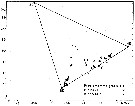 issued from : U. Brenning in Wiss. Z. Wilhelm-Pieck-Univ. Rostock - 35. Jahrgang 1986. Mat.-nat. wiss. Reihe, 5. [p.10, Fig.7]. issued from : U. Brenning in Wiss. Z. Wilhelm-Pieck-Univ. Rostock - 35. Jahrgang 1986. Mat.-nat. wiss. Reihe, 5. [p.10, Fig.7].
T-S Diagram for Pleuromamma boreals, P. piseki and P. gracilis from 8° S - 26° N; 16°- 20° W.
SO: Southern Surface Water (S °/oo: 34,50; T°C: 29,0); ND: Northern Water of the Surface Layer (S °/oo: 37,5; T°C: 21,0); SD: Southern Deep Water of the surface layer (S °/oo: 35,33; T°C: 13,4). See commentary in Temora stylifera and Brenning (1985 a, p.6). |
 Issued from : A. Dessier in Oceanol. Acta, 1983, 6 (1). [p.101, Fig.8 C]. Issued from : A. Dessier in Oceanol. Acta, 1983, 6 (1). [p.101, Fig.8 C].
Geographic distribution of Pleuromamma borealis along the transect Noumea (New Caledonia) to Panama.
black square: more than 18 organisms; black point inside square: 1 to 18 organisms.
Nota: Sampling by net (mesh aperture = 330 µ) between depth 5 and 10 m, 34 hours after sunset. From November 1977 to September 1981 (90 % of samples obtained since 1979). |
 Issued from : P. Tutasi, S. Palma & M. Caceres in Scienc. Mar., 2011, 75 (4). [p.798, Fig.7 c] Issued from : P. Tutasi, S. Palma & M. Caceres in Scienc. Mar., 2011, 75 (4). [p.798, Fig.7 c]
Geographic distribution of Pleuromamma borealis in September and October 2001, associated with the weak La Niña event of 2001. |
 Issued from : P.-E. Lapernat in DEA Océanogr. Biol., Univ. P. & M. Curie, Paris VI. July 5, 2000. [Fig.9 g]. Issued from : P.-E. Lapernat in DEA Océanogr. Biol., Univ. P. & M. Curie, Paris VI. July 5, 2000. [Fig.9 g].
Verical distribution of Pleuromamma borealis at an eutrophic site (off Mauritanian coast: 20°32 'N, 18°36' W) in females (F) and males (M) (ind. per m3) in the day (white circle) and night (black circle).
Nota: Sampling in the water column 0-1000 m, one during the day and another during the night with BIONESS multiple-net: 0-75; 75-150; 150-250; 250-350; 350-450; 450-550; 550-700; 700-850; 850-965 m. In May-June 1992. |
| | | | Loc: | | | sub-Antarct. (SW & SE Pacif., Indian), South Africa (E & W), Namibia, Congo, G. of Guinea, Brazil, off Amazon, Cape Verde Is., off Mauritania-NW Cape Verde Is., off Morocco-Mauritania, Canary Is., off Madeira, Lisboa, off W Cabo Finisterre, Bay of Biscay, NW Atlant., W Ireland, off SW Ireland, Ibero-moroccan Bay, off Bermuda: Station ‘’ S’’ (32°10’N, 64°30’W), off Cape Hatteras, Sargasso Sea, Nova Scotia, off SE Nova Scotia, Labrador (coast), off E Newfoundland, S Iceland, Ireland (S, W & NE), Faroe Is., North Sea, off W Tangier, Medit. (Alboran Sea, Gulf of Annaba, El Kala shelf, Baleares, Ligurian Sea, Tyrrhenian Sea, Strait of Messina, W Egyptian coast), Natal, Indian, S Indian (subtropical convergence), W Australia, Philippines, China Seas (Yellow Sea, East China Sea, South China Sea), Taiwan (N: Mienhua Canyon, NW), S Korea, Pacif. (E & W equatorial), New Caledonia, Tasman Sea, New Zealand (W, S: sub-Antarctic), Oregon (off Newport), California, Santa Monica Bsin, Sixtymile Bank, W BaJa California, off W Guatemala, Pacif. (equatorial), W Colombia, Galapagos-Ecuador, Peru, N Chile | | | | N: | 113 | | | | Lg.: | | | (16) F: 1,8; (22) F: 2,46-1,67; M: 2,13-1,47; (35) F: 2,34-2,28; (47) F: 2,5-2; (73) F: 1,98-1,93; (101) F: 2,01-1,83; ?(142) F: 2-1; M: 2-1; (180) F: 2-1,8; (199) F: 1,9-1,67; M: 1,75-1,44; (237) F: 1,9-2,0; (290) F: 1,85; M: 1,85; (327) F: 2,22-1,95; M: 1,69-1,67; (432) F: 2,45-2,25; (909) F: 2,3; M: 1,72-1,8; (1023) F: 1,92; (1108) F: 1,92-2,4; M: 1,63-1,83; {F: 1,67-2,50; M: 1,44-2,13}
The mean female size is 2.051 mm (n = 26; SD = 0.2483), and the mean male size is 1.726 mm (n = 11; SD = 0.1888). The size ratio (male : female) is 0.86 (n = 6; SD = 0.0851). | | | | Rem.: | épi-mésopélagique.
Sampling depth (sub-Antarct.) : 0-600 m.
Voir aussi les remarques en anglais | | | Dernière mise à jour : 28/10/2022 | |
|
|
 Toute utilisation de ce site pour une publication sera mentionnée avec la référence suivante : Toute utilisation de ce site pour une publication sera mentionnée avec la référence suivante :
Razouls C., Desreumaux N., Kouwenberg J. et de Bovée F., 2005-2024. - Biodiversité des Copépodes planctoniques marins (morphologie, répartition géographique et données biologiques). Sorbonne Université, CNRS. Disponible sur http://copepodes.obs-banyuls.fr [Accédé le 20 avril 2024] © copyright 2005-2024 Sorbonne Université, CNRS
|
|
 |
 |



















